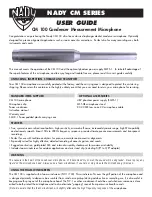
SETTING-UP
3
Wireless
Wireless
SETTING-UP
4
1 0
1 1
1 2
13
14
5.2 Setting up the transmitter
Connect 6.3
Φ
plug or XLR plug of the wired microphone in MIC IN jack on
the transmitter rear panel. Turn the MIC Volume Control on the transmitter
clockwise to set the transmitter input to receiver level.
Use the RCA plug to connect the Audio In jack on the transmitter rear panel.
Turn the Line Volume control on the transmitter clockwise to set the
transmitter input to receiver level.
For monitoring purpose, plug the headphone into the monitoring headphone
jack on the front panel of transmitter. Turn the Monitoring Headphone Volume
on the transmitter clockwise to set the headphone volume.
5.3 Setting up the frequency
For 16 channels model, adjust channel rotary to select channel to set up
frequency.
For 64 channels model, frequency is divided into 8 groups, which there are 8
channels in each group. Adjust group rotary to setup group number. Adjust
channel rotary to setup channel number.
Fig.3 rear pa n el
5. Setting-Up
N
OTICE: Prior to setting up, please make sure the microphone and the
receiver are turned to the same frequency. Two or above wireless
microphones operating in the same frequency can not be used at the same
time and area. So please select the different frequencies which cam be used
simultaneously at the same area.
5.1 Connecting the transmitter to power
Attach the UHF antenna to the TNC connector on the rear panel.
Please check the voltage of the supplied AC adapter conforms to the voltage
available in local area. Using the wrong AC adapter may cause irreparable
damage to the unit.
Plug the feeder cable of the supplied AC adapter into DC IN socket on the
transmitter. Then plug the AC adapter into a power outlet.
THIS DEVICE COMPLIES WITH PART 15 OF THE FCC RULES. OPERATION IS SUBJECT
TO THE FOLLOWING TWO CONDITIONS: (1) THIS DEVICE MAY NOT CAUSE HARMFUL
INTERFERENCE AND (2) THIS DEVICE MUST ACCEPT ANY INTERFERENCE RECEIVED,
INCLUDING INTERFERENCE THAT MAY CAUSE UNDESIRED OPERATION.
Notice : The changes or modifications not expressly approved by the party responsible
for compliance could void the user’s authority to operate the equipment.
IMPORTANT NOTE: To comply with the FCC RF exposure compliance requirements, no
change to the antenna or the device is permitted. Any change to the antenna or the device
could result in the device exceeding the RF exposure requirements and void user’s
authority to operate the device.





















